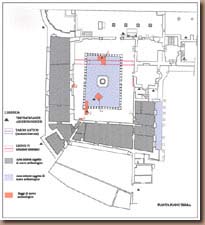Report on the archaeological excavation plan
The overall restoration plan involves a carefully designed excavation project, since the underpinning and dehumidification works make excavation necessary, and this might affect the stratigraphic and archaeological deposits to be found below. Pre-existing and stratigraphic elements certainly exist, as proven by the investigations carried out in the planning phase. Structures of great historical importance could be uncovered especially in the cloister garden and the areas on the west side. In the first case, the area is particularly sensitive since there may be a smaller cloister or service areas for the nineteenth-century basilica. In the second case, the present monastery may rest on top of the ancient early-medieval and medieval cells.
While the excavation has to do with work-site necessities, it must become a means of investigation for the reasons stated above, for historical research, which may, in turn, influence the conservation plans themselves, as the excavation proceeds - a sort of works in progress.
The excavation work is expected to last seven months, during which a group of three archaeologists, with experience in excavation and work-site restoration, will preside. They will set the guidelines for and supervise the research. University graduates or degree candidates, selected by the University or foreign Schools of Archaeology will work with them in the same discipline. It is expected that a group of eight, in addition to those in charge of the excavation, employed for theoretical and practical work in two-month shifts, will carry on the stratigraphic excavation of the areas, also the initial organisation of the excavation materials as well as the graphic and photographic documentation.
The work area involves an overall area of around 200 m2 including the cloister garden, and many of the surrounding areas. Seasonal climatic conditions will determine whether excavations of the covered areas (preferably autumn - winter) are to be performed or those of the garden (spring).
For functional (logistic and scientific) reasons, such as the moving of material, or related to the safety of the work-site personnel, it has been decided that excavation will take place in sections, defined by the present division of the areas. Only after one sector is completed and has been closed up, will work begin on the subsequent one, even if the possibility of leaving several adjoining areas open for brief periods of time for the sake of investigation , has not been excluded.
The methods of stratigraphic archaeology will be used for the excavation: after removal, with the help of workers, of present-day works (floors, walls, etc.) which will, in any case, be documented, the work will be continued for the purpose of locating the individual stratigraphic units that make up the stratigraphic layers below. After documentation (street maps, sections and photographs), these will be excavated with trowels, and the anthropic material therein will be recovered. The use of other methodologies is not excluded, if particularly large deposits are encountered (levelling or fill layers). Excavation of the land with pick and shovel will take place, but only after sample areas have been operated on, in order to establish statistically, and usable for other experiments as well, how much will not be known.
While the works are in progress, excavation will take place at the same time. The material will be organised, washed and labelled, and be classified insofar as it is necessary for the subsequent phase of research. The material will be kept in special containers in appropriate environments within the building complex.
A file will be set up containing the samples of material discovered in the excavation and belonging to the vertical structures of the complex, hence: plaster, mortar, ceramics, bricks, tiles, etc. It will thus be possible to compare this material with that of other urban excavations or use it for microscope, mineralogical or chemical research to determine, for example, the composition of the types of mortar or the source of the clay, thereby locating the production centres of the ceramics, or other items.
Since the range of research and methodologies in archaeological studies is continually broadening, and is not just limited to the vertical deposit (walls, layers, etc.) and material aspect of the culture, but also to the reconstruction of the excavated microcosm, the identification of its "ecological" essence insofar as both man and the environment have interacted (in all their components, inanimate and otherwise), it has been felt that other scientists and professionals should become involved: an anthropologist who will be in charge of studying the human bones uncovered (highly likely in a monastic environment), an archaeo-zoologist for the animal bones, and a paleo-botanist for the environmental earth and flotation tests. In this case, it will be possible to reconstruct the various habitats that have succeeded one another on the site, explore the possibility that monks grew medicinal plants or acquire information on the customs of the religious community, etc. That research will also be backed up by the tests deemed most appropriate, such as chemical, microscopic tests or pollen analyses.
For the buildings discovered during the excavation, appropriate decisions will be taken concerning their documentation and preservation. Project designs will be modified during the works if warranted by the importance of the remains uncovered, and documentation will be available to scholars for examination or use. A report, classified by activities, phases, and periods, put together with the results of the stratigraphic analyses of the structures, will constitute the logical and coherent conclusion of the work carried out.
|
© 1999 Coordination
Monica Morbidelli |
|
|
